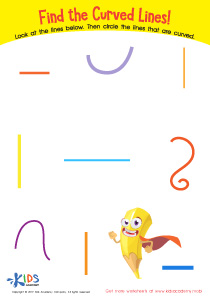Tracing Lines and Curves Worksheets for Ages 4-9
8 filtered results
-
From - To
Welcome to our Tracing Lines and Curves Worksheets designed for children aged 4-9! These engaging worksheets help young learners develop essential fine motor skills and hand-eye coordination as they trace various lines and curves. Perfect for early education, our worksheets introduce foundational concepts in writing and drawing, setting the stage for successful literacy and artistic expression. With fun designs and gradual difficulty levels, children will enjoy practicing their tracing skills while boosting their confidence. Ideal for homeschools, classrooms, or supplemental learning at home, our resources make learning enjoyable and effective. Download now and watch your child's skills grow!


Trace Diagonal Lines Worksheet


Find the Curved Lines! Worksheet


Tracing and Spacing: Assessment 1 Worksheet


First Words: Let's Trace Lines Worksheet


Curved Lines Tracing Worksheet


Tracing Horizontal Lines Worksheet


Tracing Lines Worksheet
Tracing lines and curves is an essential foundational activity for young children, particularly those aged 4 to 9. Parents and teachers should care about this developmental skill because it significantly contributes to various aspects of a child's growth. Firstly, motor skills are enhanced through tracing, as children learn to control their hand movements, grip writing tools effectively, and build hand-eye coordination. These skills are crucial for later writing abilities and overall dexterity.
Additionally, tracing lines and curves fosters cognitive development. Children learn to recognize and differentiate shapes while understanding concepts like directionality and sequence. This foundational knowledge aids in math and geometry as they progress in their education. Engaging in tracing also encourages focus and attention to detail, which are invaluable traits for successful learning.
Moreover, tracing can be a fun, creative expression. It allows children to experiment with art and design, nurturing their creativity while developing spatial awareness and visual perception. Collectively, these elements create a strong foundation for future learning, making tracing an enjoyable and meaningful activity that parents and teachers should prioritize in early education. Introducing tracing lines and curves in playful and engaging ways can set children on a path toward academic success and lifelong skills.
 Assign to My Students
Assign to My Students












